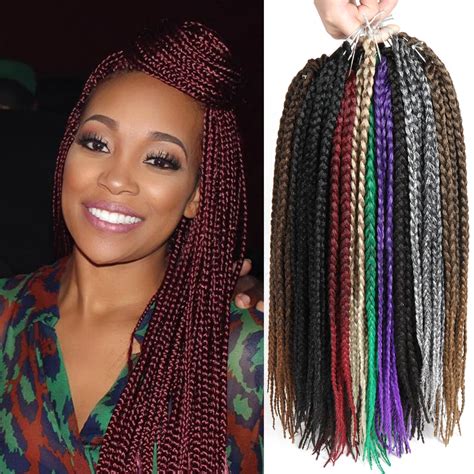Synthetic hair extensions are a versatile and affordable way to add length, volume, and style to your hair. They’re also a great option for those who want to experiment with different colors and styles without damaging their own hair.

- Box braids: A classic braiding style, box braids are square-shaped sections of hair that are braided from the root to the end.
- Cornrows: Cornrows are a type of raised braid that is created by braiding the hair in a straight line away from the scalp.
- French braids: French braids are a braid that is created by crossing three strands of hair over each other.
- Dutch braids: Dutch braids are a variation of French braids, but they are braided under instead of over.
- Fishtail braids: Fishtail braids are a type of intricate braid that is created by splitting the hair into two sections and then weaving them together.
- Rope braids: Rope braids are a simple, yet stylish braid that is created by twisting two strands of hair together.
- Waterfall braids: Waterfall braids are a beautiful and elegant braid that is created by looping strands of hair over each other.
- Headband braids: Headband braids are a quick and easy way to add a touch of style to your hair.
- Crown braids: Crown braids are a type of halo braid that is created by wrapping hair around the head.
- Bantu knots: Bantu knots are a type of small, coiled bun that is created by twisting hair around itself and then securing it with a hair tie.
- Dreadlocks: Dreadlocks are a type of long, tangled braid that is created by allowing hair to mat together naturally.
- Length: Synthetic hair extensions can add length to your hair without damaging your own hair.
- Volume: Synthetic hair extensions can add volume to thin hair.
- Style: Synthetic hair extensions come in a variety of colors and styles, so you can experiment with different looks.
- Protection: Synthetic hair extensions can protect your natural hair from heat and damage.
- Affordability: Synthetic hair extensions are an affordable way to add length, volume, and style to your hair.
- Use a braiding spray or mousse. This will help to keep your hair in place and prevent frizz.
- Braid your hair when it is slightly damp. Braiding dry hair can be difficult and can cause breakage.
- Use small sections of hair. This will help to create a tighter and more secure braid.
- Braid your hair all the way to the end. This will prevent the braid from unraveling.
- Use a hair tie to secure the braid. This will help to keep the braid in place and prevent it from coming undone.
- Using too much hair. This can make the braid too bulky and difficult to manage.
- Braiding your hair too tightly. This can cause breakage and pain.
- Not using a braiding spray or mousse. This can cause your hair to frizz and slip out of the braid.
- Not braiding your hair all the way to the end. This can cause the braid to unravel.
- Not using a hair tie to secure the braid. This can cause the braid to come undone.
Pros
- Synthetic hair extensions are an affordable way to add length, volume, and style to your hair.
- Synthetic hair extensions are available in a variety of colors and styles, so you can experiment with different looks.
- Synthetic hair extensions can protect your natural hair from heat and damage.
- Synthetic hair extensions are easy to care for.
Cons
- Synthetic hair extensions can be difficult to braid.
- Synthetic hair extensions can frizz if they are not properly cared for.
- Synthetic hair extensions can be itchy and uncomfortable to wear.
Synthetic hair extensions are a versatile and affordable way to add length, volume, and style to your hair. By following these tips, you can braid synthetic hair extensions and avoid the common mistakes.
